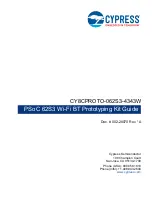
Functional Description
2. Frame synchronization lost. This error happens when the DMA engine attempts to read what it
believes to be the first word of the video buffer but it cannot be recognized as such. This could be
caused by an invalid frame buffer address or an invalid BPP value (for more details, see
). The SYNC bit in the IRQSTATUS_RAW register is set when such an error is
detected. This bit is cleared by writing a 1 to the SYNC bit in the IRQSTATUS register.
3. Palette loaded. When using palette-only or data modes, the PL bit in the IRQSTATUS_RAW
register will be set when the palette portion of a DMA transfer has been loaded into palette RAM. This
interrupt can be cleared by writing a ‘1’ to the PL bit in the IRQSTATUS register.
4. AC bias transition. If the ACB_I bit in the RASTER_TIMING_2 register is programmed with a non-
zero value, an internal counter will be loaded with this value and starts to decrement each time
LCD_AC_BIAS_EN (AC-bias signal) switches its state. When the counter reaches zero, the ACB bit in
the IRQSTATUS_RAW register is set, which will deliver an interrupt signal to the system interrupt
controller (if the interrupt is enabled.) The counter reloads the value in field ACB_I, but does not start
to decrement until the ACB bit is cleared by writing 1 to this bit in the IRQSTATUS register.
5. Frame transfer completed. When one frame of data is transferred completely, the DONE bit in the
IRQSTATUS_RAW register is set. Note that the EOF0 and EOF1 bits in the IRQSTATUS_RAW
register will be set accordingly. This bit is cleared by writing a 1 to the corresponding interrupt in the
IRQSTATUS register.
Note that the interrupt enable bits are in the IRQENABLE_SET register. The corresponding enable bit
must be set in order to generate an interrupt to the CPU. However, the IRQSTATUS_RAW register
reflects the interrupt signal regardless of the interrupt enable bits settings.
13.3.3.1.3 Interrupt Handling
See
, Interrupts, for information about LCD interrupt number to CPU. The interrupt service
routine needs to determine the interrupt source by examining the IRQSTATUS_RAW register and clearing
the interrupt properly.
13.3.4 LIDD Controller
The LIDD Controller is designed to support LCD panels with a memory-mapped interface. The types of
displays range from low-end character monochrome LCD panels to high-end TFT smart LCD panels.
LIDD mode (and the use of this logic) is enabled by clearing the MODESEL bit in the LCD control register
(LCD_CTRL).
LIDD Controller operation is summarized as follows:
•
During initialization, the LCD LIDD CS0/CS1 configuration registers (LIDD_CS0_CONF and
LIDD_CS1_CONF) are configured to match the requirements of the LCD panel being used.
•
During normal operation, the CPU writes display data to the LCD data registers (LIDD_CS0_DATA and
LIDD_CS1_DATA). The LIDD interface converts the CPU write into the proper signal transition
sequence for the display, as programmed earlier. Note that the first CPU write should send the
beginning address of the update to the LCD panel and the subsequent writes update data at display
locations starting from the first address and continuing sequentially. Note that DMA may be used
instead of CPU.
•
The LIDD Controller is also capable of reading back status or data from the LCD panel, if the latter has
this capability. This is set up and activated in a similar manner to the write function described above.
NOTE:
If an LCD panel is not used, this interface can be used to control any MCU-like peripheral.
See your device-specific data manual to check the LIDD features supported by the LCD controller.
describes how the signals are used to interface external LCD modules, which are configured
by the LIDD_CTRL register.
1106
LCD Controller
SPRUH73H – October 2011 – Revised April 2013
Copyright © 2011–2013, Texas Instruments Incorporated















































